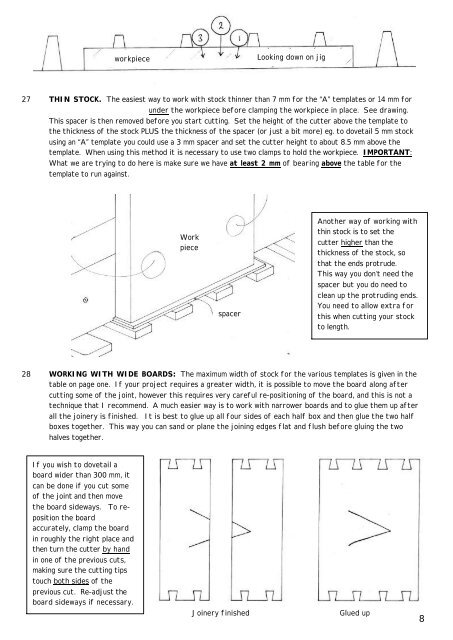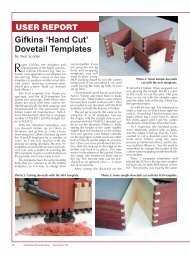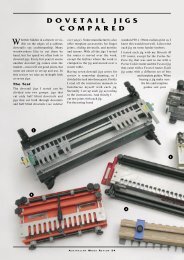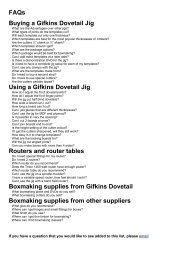Instructions for web - Gifkins Dovetail Jig
Instructions for web - Gifkins Dovetail Jig
Instructions for web - Gifkins Dovetail Jig
Create successful ePaper yourself
Turn your PDF publications into a flip-book with our unique Google optimized e-Paper software.
27 THIN STOCK. The easiest way to work with stock thinner than 7 mm <strong>for</strong> the “A” templates or 14 mm <strong>for</strong><br />
under the workpiece be<strong>for</strong>e clamping the workpiece in place. See drawing.<br />
This spacer is then removed be<strong>for</strong>e you start cutting. Set the height of the cutter above the template to<br />
the thickness of the stock PLUS the thickness of the spacer (or just a bit more) eg. to dovetail 5 mm stock<br />
using an “A” template you could use a 3 mm spacer and set the cutter height to about 8.5 mm above the<br />
template. When using this method it is necessary to use two clamps to hold the workpiece. IMPORTANT:<br />
What we are trying to do here is make sure we have at least 2 mm of bearing above the table <strong>for</strong> the<br />
template to run against.<br />
28 WORKING WITH WIDE BOARDS: The maximum width of stock <strong>for</strong> the various templates is given in the<br />
table on page one. If your project requires a greater width, it is possible to move the board along after<br />
cutting some of the joint, however this requires very careful re-positioning of the board, and this is not a<br />
technique that I recommend. A much easier way is to work with narrower boards and to glue them up after<br />
all the joinery is finished. It is best to glue up all four sides of each half box and then glue the two half<br />
boxes together. This way you can sand or plane the joining edges flat and flush be<strong>for</strong>e gluing the two<br />
halves together.<br />
If you wish to dovetail a<br />
board wider than 300 mm, it<br />
can be done if you cut some<br />
of the joint and then move<br />
the board sideways. To re-<br />
position the board<br />
accurately, clamp the board<br />
workpiece<br />
in roughly the right place and<br />
then turn the cutter by hand<br />
in one of the previous cuts,<br />
making sure the cutting tips<br />
touch both sides of the<br />
previous cut. Re-adjust the<br />
board sideways if necessary.<br />
Work<br />
piece<br />
spacer<br />
Looking down on jig<br />
Another way of working with<br />
thin stock is to set the<br />
cutter higher than the<br />
thickness of the stock, so<br />
that the ends protrude.<br />
This way you don’t need the<br />
spacer but you do need to<br />
clean up the protruding ends.<br />
You need to allow extra <strong>for</strong><br />
this when cutting your stock<br />
to length.<br />
Joinery finished Glued up<br />
8







